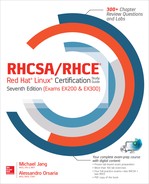Book Description
Based on Red Hat Enterprise Linux 7, the new edition of this bestselling study guide covers the updated Red Hat Certified System Administrator (RHCSA) and Red Hat Certified Engineer (RHCE) exams.
RHCSA/RHCE Red Hat Linux Certification Study Guide, 7th Edition is fully revised to cover the recently released Red Hat Enterprise Linux 7 and the corresponding RHCSA and RHCE certification exams. This new edition provides complete coverage of all official exam objectives for the new exams.
An integrated study system based on proven pedagogy, this revised bestseller features special elements that reinforce and teach practical skills while preparing candidates for the exam. Each chapter includes step-by-step exercises, Exam Watch and On-the-Job sidebars, Two-Minute Drills, end-of-chapter self tests, and hands-on lab questions. Electronic content includes four complete lab-based practice exams to ensure you’re ready to sit for the live exams.
- Complete coverage of all exam objectives and performance-based requirements related to the exams, including difficult lab-based scenarios
- Electronic content includes four complete lab-based practice exams, two for RHSCA and two for RHCE
- A proven study system for RHCSA and RHCE candidates
